
Saumya Sharma
Summary
- Linc allows companies to automate customer service & customer experience by allowing retailers to automate around 70% of the customer queries.
- Each year, US enterprises lose around $62 billion in revenues due to poor customer service, according to cloud platform company NewVoiceMedia.
- The retail churn rate—the share of customers who stopped shopping at a particular retailer or opted out from a subscription service—was 27% for US brick-and-mortar stores in 2018.
- With Linc, customers can receive updates and answers about orders, tracking, returns and products, and get contextual and personalized recommendations. Linc’s platform delivers its services across several channels such as Facebook Messenger, SMS, live chat / chatbot, voice assistants, web, email and more.
- Queries about order and return issues can account for as much as 50% of the total received by a customer service agent. Linc’s automation reduces these queries by 25–30%, which can help retailers cut operational costs and improve shopper interactions.
- Linc's proprietary technology solves some of the key challenges in building a multi-service conversational “assistant,” making it possible for retailers to build further use cases for their automated assistants.
Introduction
This report forms part of our Innovator Intelligence series, which focuses on emerging companies that are disrupting retail and fueling innovation across the retail value chain. Here, we examine Linc Global, which enables companies to improve the customer experience through automation. Its platform can address customer queries in real time while reducing costs for retailers. Customer experience is crucial to any business and has a direct impact on revenues and profitability. Each year, US companies lose about $62 billion in revenues due to poor customer service, according to cloud platform company NewVoiceMedia. Furthermore, better customer experience yields higher revenues—seven in ten US customers said that they would spend more on a company’s products if they are satisfied with its customer service, according to American Express. In today’s channel-rich environment, it has become more important than ever for retailers to train service representatives to quickly develop personal connections with customers and resolve their queries promptly. Customers can be quick to switch between retailers. According to an American Express survey of 1,000 US adults titled “Customer Service Barometer,” 33% of the respondents considered switching companies immediately after a bad experience, while 60% switched after 2–3 instances of poor service. Retailers need to leverage advances in automation to provide superior and timely customer care and keep up with shoppers’ demand for immediacy. Automation can provide a long-term solution for creating a compelling customer experience, reducing continuous training efforts. This has substantial cost benefits: Companies spend around $4,000 or more to find and hire a call center agent in the US, with an additional $4,800 in training cost. This adds up, given the high average turnover rates observed in call centers in the US, according to IBM. Linc allows enterprises to automate customer care by leveraging AI. Its technology enables retailers to automate around 70% of their customer service queries. The company offers programming solutions that not only address queries promptly but also provide curated recommendations and personalized offers. Furthermore, Linc can automate customer care across various channels such as Facebook Messenger and SMS, and it can also answer queries on voice assistants such as Amazon Alexa and Google Assistant with the help of voice commands. Linc enables enterprises to automate the customer experience through:- Pre-built services that solve around 70% of customer queries about orders and at the same time create new revenue through campaigns and contextual product recommendations.
- Platform extensibility, which allows companies to add as many automation services as they want. Retailers can adopt various features such as marketing campaigns and product recommendations for the automated chat assistant.
- Integrations that enable enterprises to assimilate Linc’s automation assistance into their existing technology platforms across e-commerce, logistics and marketing. Its advanced automation allows clients to leverage the additional information available on their existing platforms.
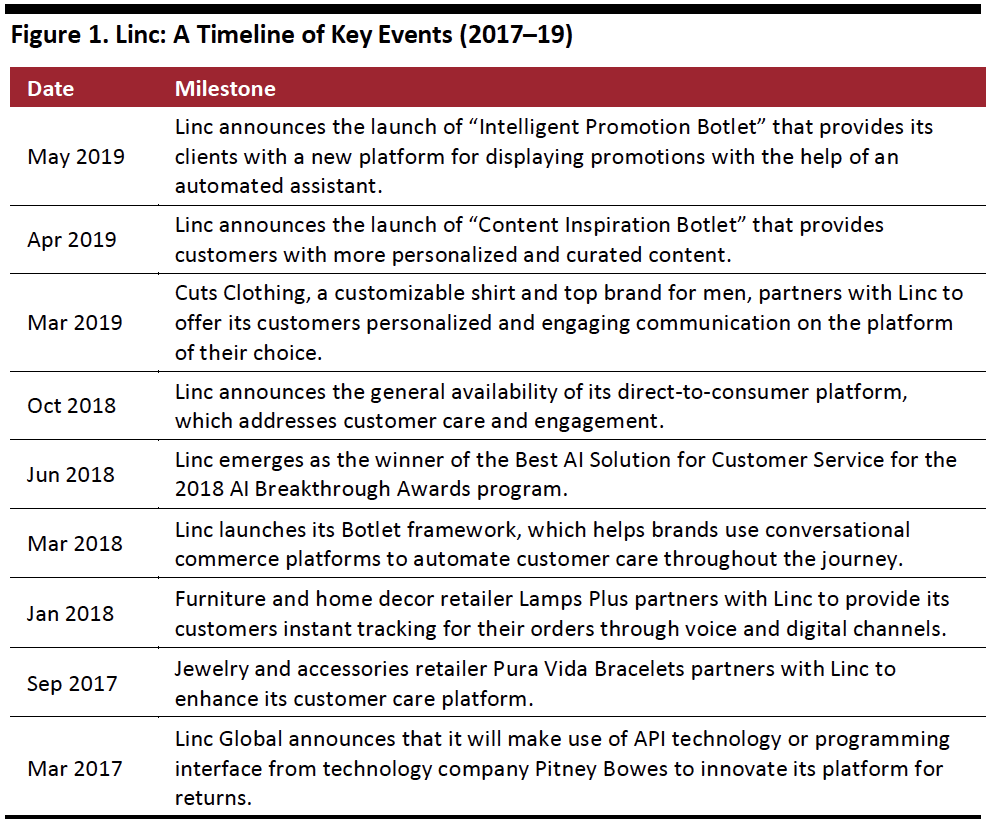 Source: Company website/Coresight Research[/caption]
Source: Company website/Coresight Research[/caption]
Industry Overview
Consumer Expectations Increasing, yet Unmet In today’s retail landscape, where consumers have a broad range of choices of shopping destinations, it has become increasingly important for retailers to build strong customer relationships. Shoppers increasingly engage with retailers in multiple channels before making a purchase. During last year’s holiday season, purchases made on desktop computers accounted for 60% of the total revenues from US online sales, followed by smartphones with 31% and tablets with 9% share of the total, according to Adobe Digital Insights. Owing to this trend, it has become necessary for retailers to provide customers with the best user-experience across all retail touchpoints. Customers often do not feel valued and are rarely satisfied across a variety of services offered by customer support teams, according to business management and consulting company Northridge Group (NRG). Its data suggests that it is important for retailers’ customer service teams to deeply understand shoppers and their shopping history with the company in order to serve customers well and in turn drive further loyalty. [caption id="attachment_90706" align="aligncenter" width="700"]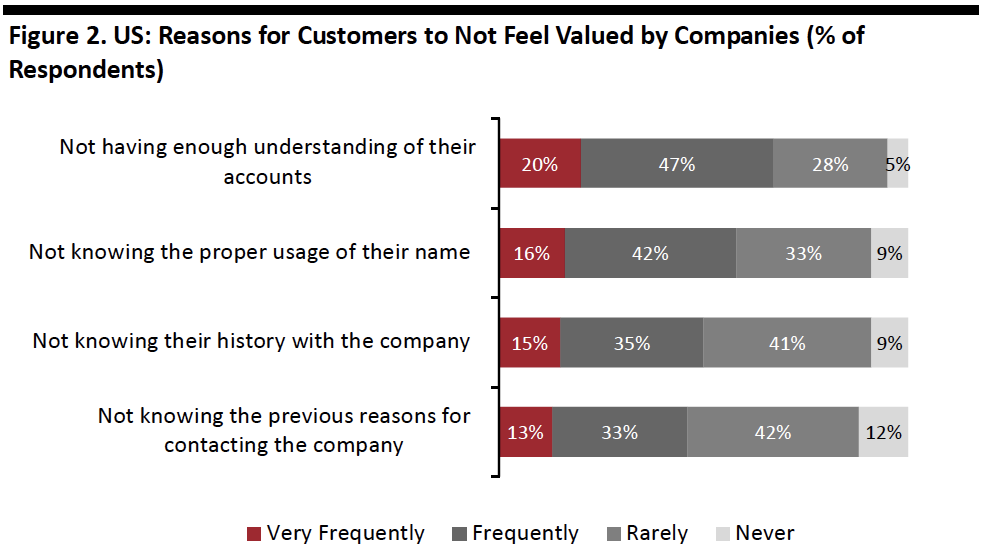 Base: 1,000 US consumers ages 18+
Base: 1,000 US consumers ages 18+Source: The Northridge Group[/caption] In addition, it is notable that the retail churn rate—the share of customers who stopped shopping at a particular retailer or opted out of a subscription service—was 27% for US brick-and-mortar retailers in 2018. Moreover, the US online retail segment recorded a 22% churn rate, which indicates the stiff competition that US online retailers also face. [caption id="attachment_90707" align="aligncenter" width="700"]
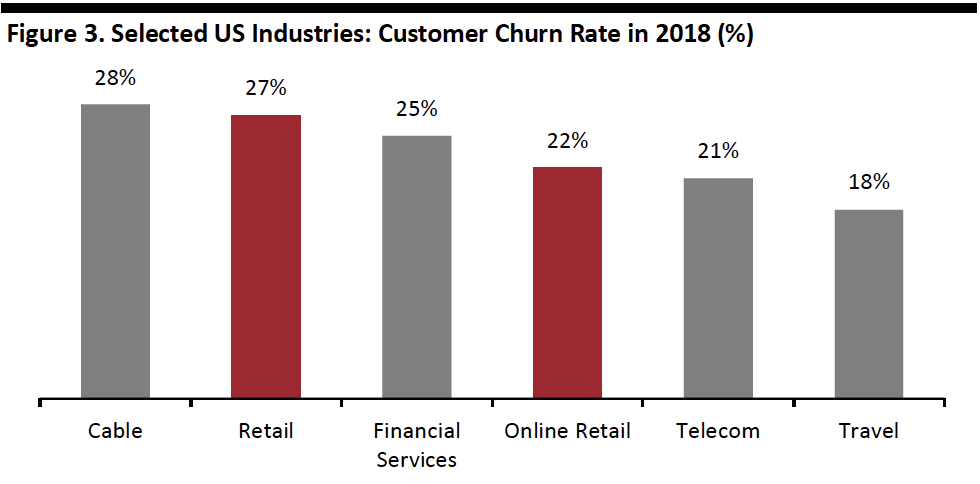 Base: 1,000 US consumers ages 18+
Base: 1,000 US consumers ages 18+Source: The Northridge Group[/caption] Digital Channels Failing to Live Up to Their Potential With increased digitalization and retailers shifting their focus to multi-channel selling, consumers have a growing preference for receiving shopper assistance across various media, such as web-based service, text messaging, social media messaging platforms and chatbots. However, this doesn’t necessarily mean that retailers have been able to bridge the gap between consumer preferences for digital channels and customer service. Nor do these efforts seem close to successful implementation, since consumers have continually showed dissatisfaction across various customer service platforms. In the four years leading to 2018, consumer preference for web-service increased by 25%, while the preference for online chat increased by 21%, according to a 2018 NRG survey of 1,000 US adults. In contrast, 66% of surveyed consumers said they had problems finding answers on company websites and only 33% classified text messages as an easy-to-use service. In addition, there is a distinct divide between shoppers in the US and elsewhere in the world about whether the quality of customer experience has improved in recent times. In a 2018 survey by Microsoft, 58% of US shoppers believed that customer service in general had improved compared with the past. This was considerably less than the 66% of respondents outside the US stating that customer service experience had improved. [caption id="attachment_90708" align="aligncenter" width="700"]
 Base: 5,000 US and global consumers ages 18+
Base: 5,000 US and global consumers ages 18+Source: Microsoft[/caption] This leaves US retailers to fill in the gaps for consumers who feel that their customer experience offerings do not meet expectations. We see opportunities for retailers that are focused on building the consumer experience around all stages of the shopping journey: before, during and after the customer makes a purchase. The illustration on the next page shows this concept in action. [caption id="attachment_91031" align="aligncenter" width="700"]
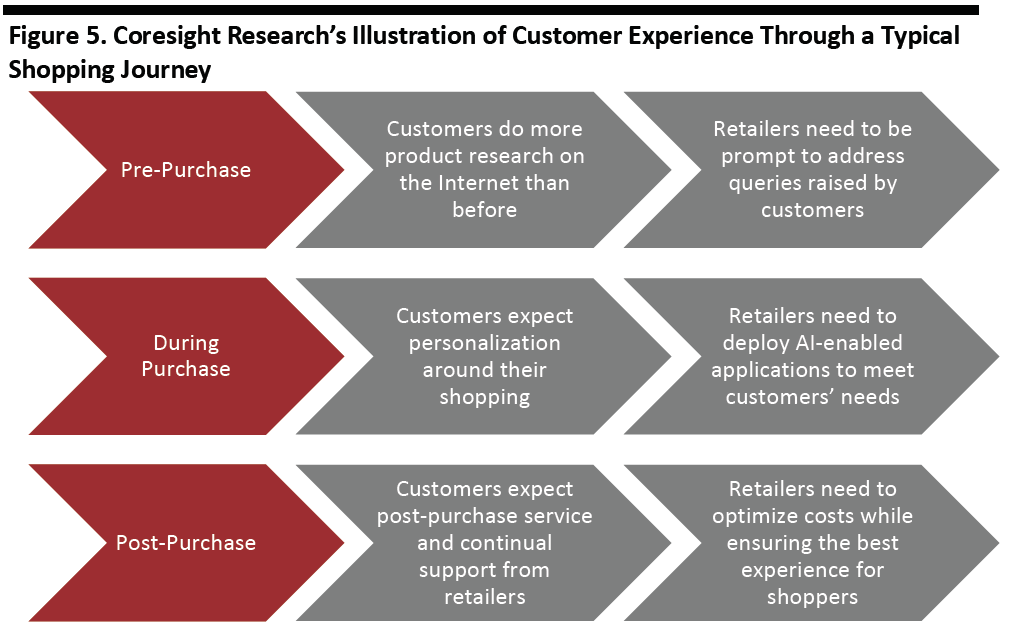 Source: Coresight Research[/caption]
Digital channels now have a greater impact on buying decisions as more consumers begin their shopping journey online. This also means that the “pre-purchase” customer experience is as important as that during or after making a purchase.
The Role of Artificial Intelligence (AI) in Reshaping the Customer Experience
AI has marked its importance across various sectors. With cheaper programming and enhanced algorithms, AI has successfully been able to automate many processes while reducing costs associated with manual labor.
It is important to understand the effectiveness of AI in building the customer experience and the cost advantages of AI solutions. It is also important to understand how retailers need to address the issues their customers face in the context of subpar customer experience. We discuss two key aspects of AI in the light of consumer pain points around customer experience.
1. Personalization of Data
Retailers need to develop a deeper understanding of consumers to become more efficient at engaging them. This has not been the case, to a broad extent, as retailers have failed to create personalized experiences for their shoppers. About 59% of the respondents surveyed by Cognizant and Forrester in 2017 stated that the retailers at which they shop do not know about their likes, dislikes and preferences.
Not all shoppers provide the same value or revenue stream for retailers. The top 1% of customers are worth 18 times more than the average customer, according to software development company RJMetrics. Hence, it is all the more valuable to know the shopping habits of these individuals and tailoring service precisely to them.
Customers now want hyper-personalization; they expect relevant content sent to them on the right device and at the right time. This level of customization will act as a competitive advantage for retailers and will enable them to sustain their market share, while reducing customer churn.
2. Enhanced Customer Support
Support is one of the key building blocks of customer experience. By 2020, 25% of customer service operations will integrate chatbot technology across channels, up from less than 2% in 2017, according to Gartner. Enterprises can deploy AI-enabled conversational interfaces such as chatbots and virtual assistants to resolve customer issues.
This automation reduces not just costs but response time. High attrition rates in the industry are a big challenge for retailers—and, in many cases, attrition is one of the key drivers for automation around customer experience.
Although chatbots are designed to answer only a set of basic questions, they are quite effective at resolving a number of customer queries instantly. In addition, chatbot technology is only becoming more advanced as time goes on. Only 12% of US respondents stated that chatbots are ineffective in resolving queries, according to a 2017 survey by Microsoft.
[caption id="attachment_90710" align="aligncenter" width="700"]
Source: Coresight Research[/caption]
Digital channels now have a greater impact on buying decisions as more consumers begin their shopping journey online. This also means that the “pre-purchase” customer experience is as important as that during or after making a purchase.
The Role of Artificial Intelligence (AI) in Reshaping the Customer Experience
AI has marked its importance across various sectors. With cheaper programming and enhanced algorithms, AI has successfully been able to automate many processes while reducing costs associated with manual labor.
It is important to understand the effectiveness of AI in building the customer experience and the cost advantages of AI solutions. It is also important to understand how retailers need to address the issues their customers face in the context of subpar customer experience. We discuss two key aspects of AI in the light of consumer pain points around customer experience.
1. Personalization of Data
Retailers need to develop a deeper understanding of consumers to become more efficient at engaging them. This has not been the case, to a broad extent, as retailers have failed to create personalized experiences for their shoppers. About 59% of the respondents surveyed by Cognizant and Forrester in 2017 stated that the retailers at which they shop do not know about their likes, dislikes and preferences.
Not all shoppers provide the same value or revenue stream for retailers. The top 1% of customers are worth 18 times more than the average customer, according to software development company RJMetrics. Hence, it is all the more valuable to know the shopping habits of these individuals and tailoring service precisely to them.
Customers now want hyper-personalization; they expect relevant content sent to them on the right device and at the right time. This level of customization will act as a competitive advantage for retailers and will enable them to sustain their market share, while reducing customer churn.
2. Enhanced Customer Support
Support is one of the key building blocks of customer experience. By 2020, 25% of customer service operations will integrate chatbot technology across channels, up from less than 2% in 2017, according to Gartner. Enterprises can deploy AI-enabled conversational interfaces such as chatbots and virtual assistants to resolve customer issues.
This automation reduces not just costs but response time. High attrition rates in the industry are a big challenge for retailers—and, in many cases, attrition is one of the key drivers for automation around customer experience.
Although chatbots are designed to answer only a set of basic questions, they are quite effective at resolving a number of customer queries instantly. In addition, chatbot technology is only becoming more advanced as time goes on. Only 12% of US respondents stated that chatbots are ineffective in resolving queries, according to a 2017 survey by Microsoft.
[caption id="attachment_90710" align="aligncenter" width="700"]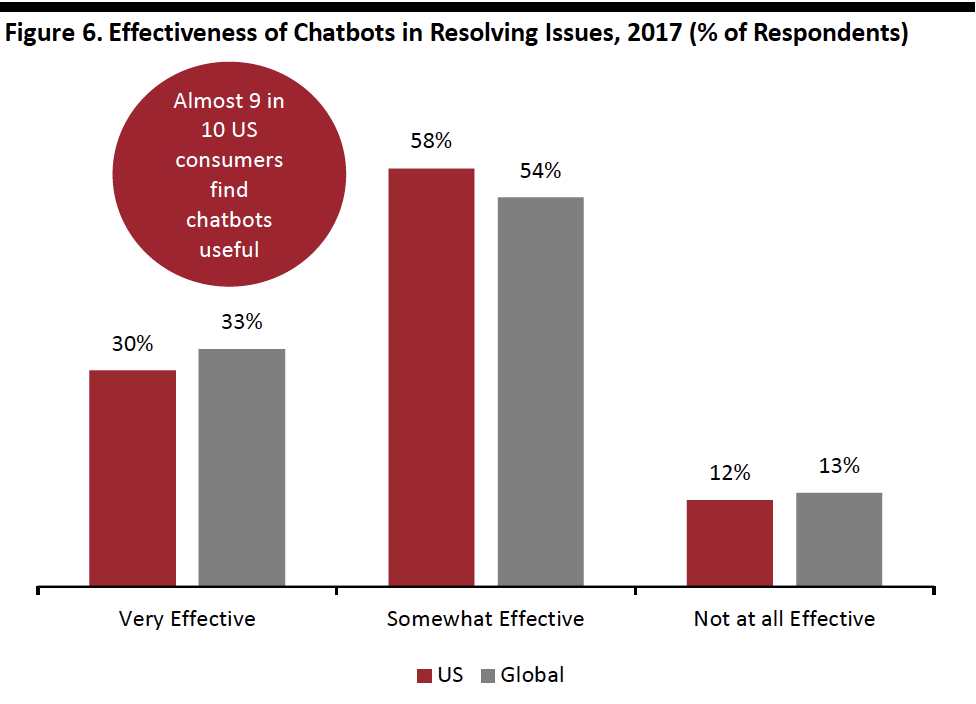 Base: 5,000 US and global consumers ages 18+
Base: 5,000 US and global consumers ages 18+Source: Microsoft[/caption]
Linc’s Platform and Solutions for Enterprises
Customers expect easy access to assistance, proactive communication and availability of information on multiple channels. Linc helps enterprises address customer queries quickly and make personalized recommendations, leveraging its automation capabilities while reducing costs for companies. Linc’s platform offers various levels of customization under three categories: pre-built services, platform extensibility and platform integrations. 1. Pre-Built Services This includes Linc’s primary AI-enabled assistant that automates customer assistance for its clients. The assistant can interact with customers across channels such as Facebook Messenger, email, SMS and Twitter. It can also answer customer queries on voice assistants such as Amazon Alexa and Google Assistant with the help of commands such as, “Hi Google, ask eBags where is my order.” Some notable features of the pre-built services platform:- Linc’s out-of-box solution automates around 70% of the most common use-cases that fall under customer service. This includes data points such as order information, tracking details, returns or exchanges, and reordering.
- The pre-built services platform develops a comprehensive understanding of the customer by creating an on-platform unified customer profile, spanning across attributes such as customer sentiment and preferences.
- The pre-built platform also provides enterprises with insights on customers’ behavioral attributes.
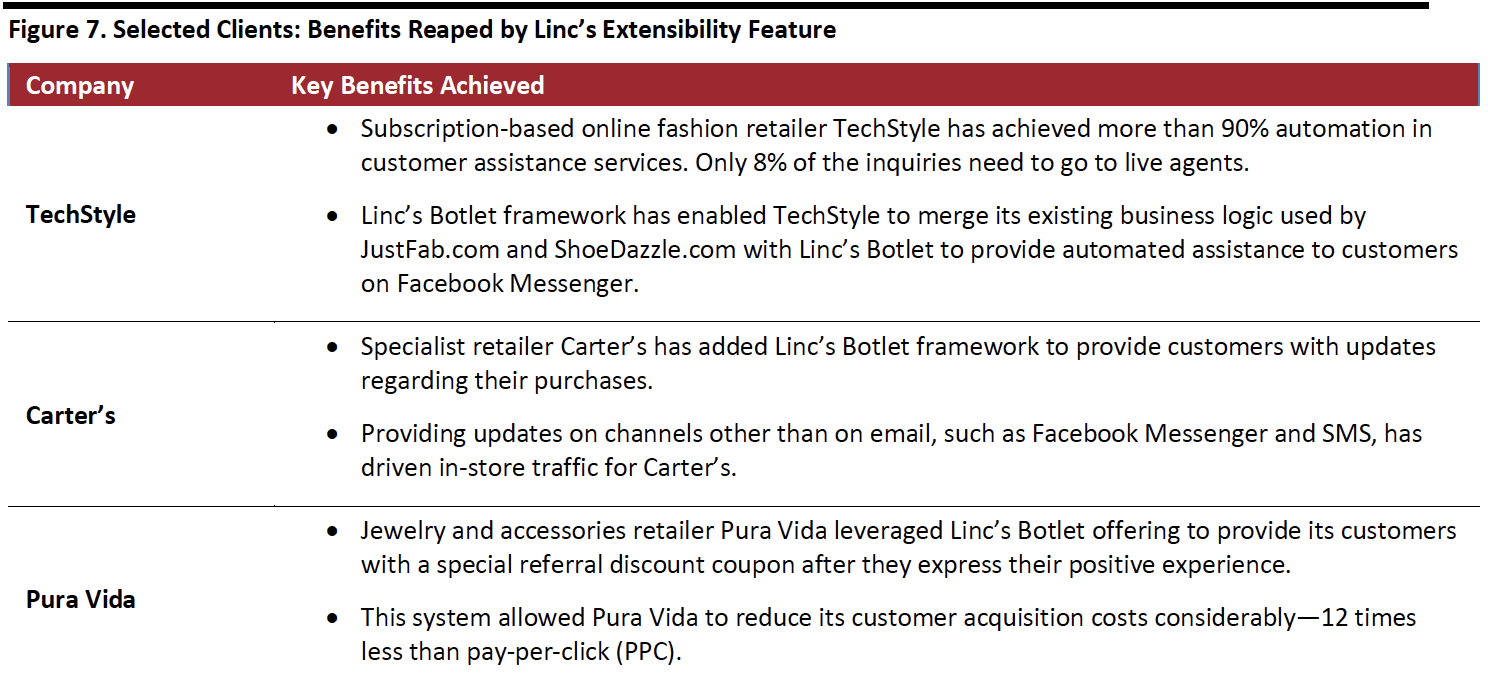 Source: CSIL/company reports/United States International Trade Commission (USITC)/Coresight Research[/caption]
Linc’s Botlets not only provide extensive automation and eliminate costs associated with human capital, but they also remove the need for cross-department IT and other data integration tools and algorithms. Linc’s unified customer profiles—which present more than 200 attributes of its customers in one place—help the Botlets achieve this.
[caption id="attachment_90712" align="aligncenter" width="700"]
Source: CSIL/company reports/United States International Trade Commission (USITC)/Coresight Research[/caption]
Linc’s Botlets not only provide extensive automation and eliminate costs associated with human capital, but they also remove the need for cross-department IT and other data integration tools and algorithms. Linc’s unified customer profiles—which present more than 200 attributes of its customers in one place—help the Botlets achieve this.
[caption id="attachment_90712" align="aligncenter" width="700"]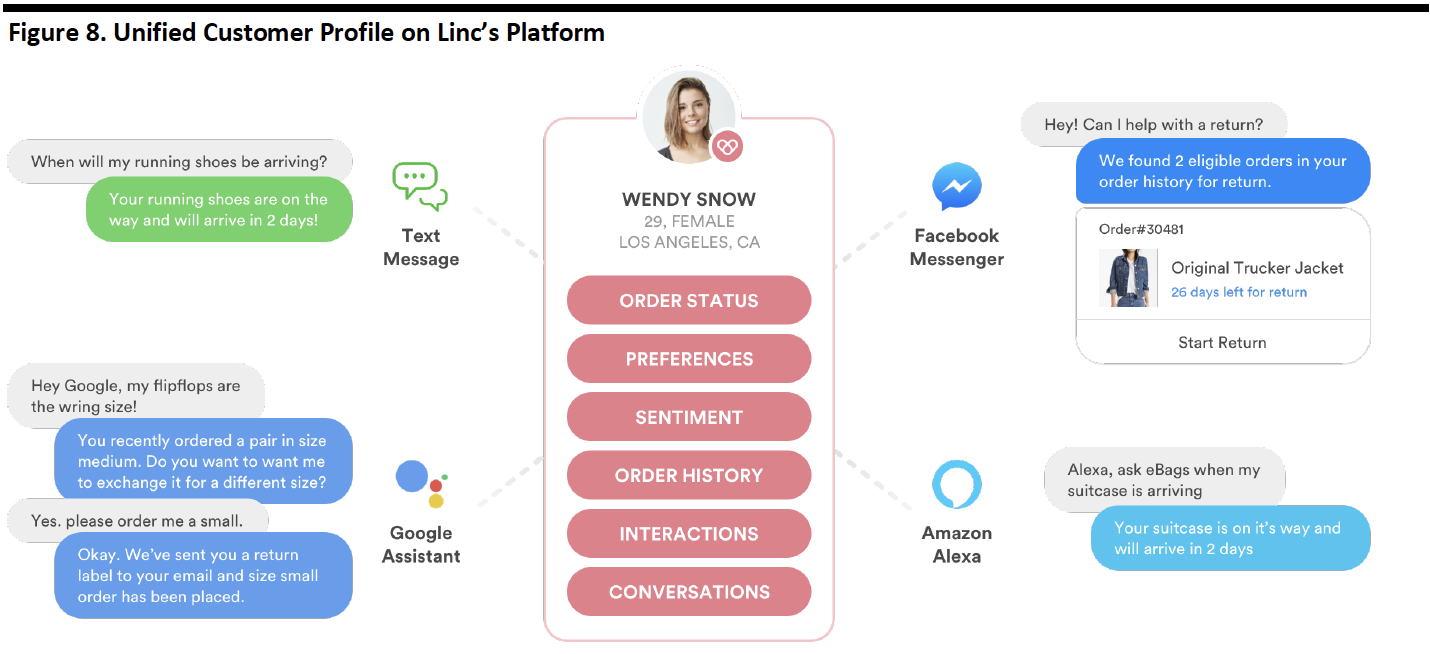 Source: Company website[/caption]
3. Platform Integrations
Linc’s open API lets it integrate its offering with existing platforms across various verticals such as e-commerce, email, shipping, community and customer support. Some of these platforms do not have turn-key integrations, but Linc’s integration programming can make them readily available for use.
Integrations not only enhance the platform functionality but also provide companies flexibility by automating selected functions on the platform through which they operate.
Linc’s solutions range across e-commerce, operations, customer service and marketing. Their benefits include:
Source: Company website[/caption]
3. Platform Integrations
Linc’s open API lets it integrate its offering with existing platforms across various verticals such as e-commerce, email, shipping, community and customer support. Some of these platforms do not have turn-key integrations, but Linc’s integration programming can make them readily available for use.
Integrations not only enhance the platform functionality but also provide companies flexibility by automating selected functions on the platform through which they operate.
Linc’s solutions range across e-commerce, operations, customer service and marketing. Their benefits include:
- Proactive communication. Not only does Linc automate customer experience, but it also provides customers with order updates on their preferred platform.
- Bot-to-agent handover. Because customer needs can be very diverse, automation might not be able to solve all customer queries. Linc’s algorithm recognizes the instances when a query needs to be transferred to a live agent and ensures seamless transfer of information.
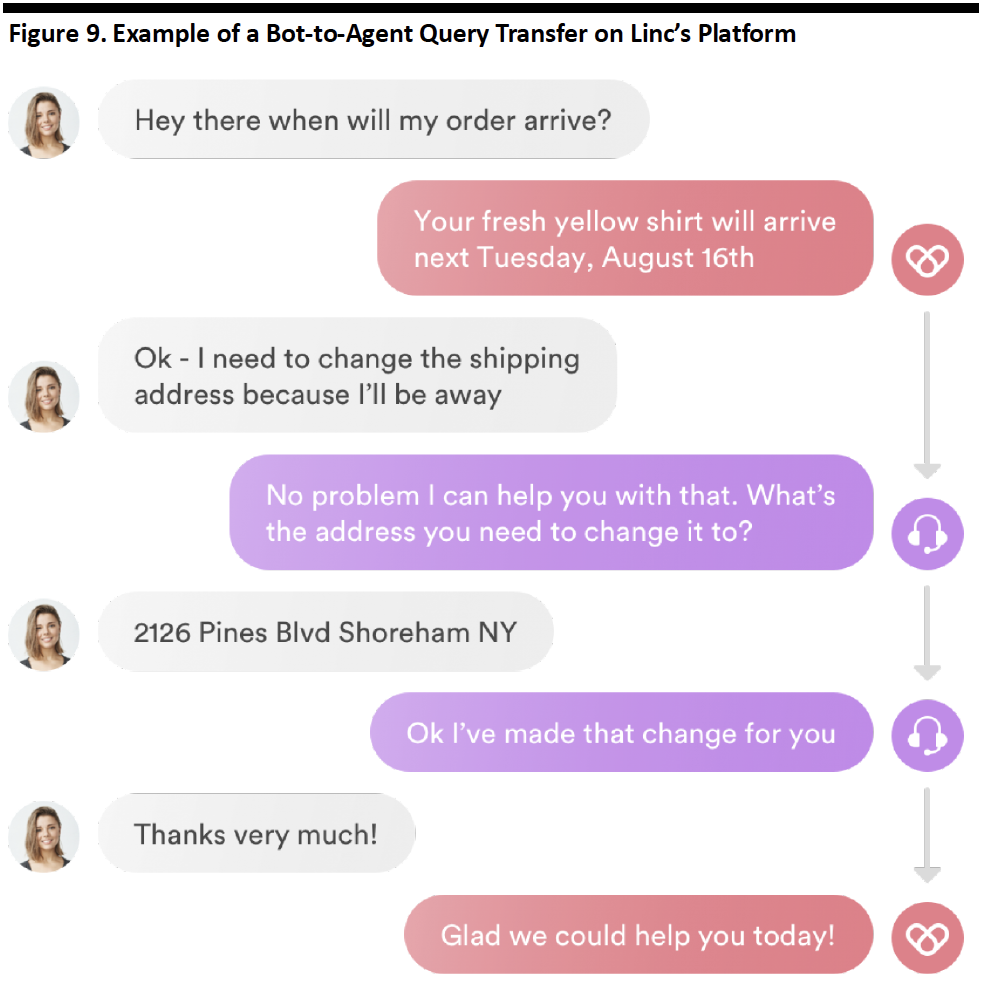 Source: Company Website[/caption]
Source: Company Website[/caption]
- Reduction in Where Is My Order (WISMO) queries. WISMO queries can account for as much as 50% of the total queries received by a customer service agent. Linc’s automation reduces WISMO queries by 25–30%.
- Real-time visibility to companies on returns. Retailers readily get updates and information about customer returns. Additionally, Linc provides details on parameters such as customer ID and the reason for a return.
- Contextual and Personalized recommendations. Linc's platform maps interaction data to structured understanding of the "moment" a customer is in and takes that as an input to contextualize its recommendations. In addition, it allows businesses to specifically target customers' sentiment, for example, contextually trigger a refer-a-friend campaign when customer expressed explicit positive sentiment.
Linc Global: Selected Case Studies
 How Linc Helped TechStyle Fashion Group
Linc has helped subscription-based online fashion retailer TechStyle in realizing its strategic initiative: to keep support queries originating on social media platforms from crossing into its traditional service channels such as email and telephone support.
Initially, TechStyle introduced automation services on Facebook Messenger while continuing email support, but discontinued email as a support channel later. This was largely due to the appeasing results achieved by the Messenger chatbot. Furthermore, the Messenger chatbot handled seven out of 10 customer interactions.
Not only does TechStyle automate resolution to queries through Linc, but it also leverages its extensibility to provide customers with suggestions and membership assistance.
TechStyle Strategic Operations VP Anna Pettus said, “Transferring contact volume to an automated assistant is a win-win for the consumer and TechStyle. Quick and efficient real-time support.”
How Linc Helped TechStyle Fashion Group
Linc has helped subscription-based online fashion retailer TechStyle in realizing its strategic initiative: to keep support queries originating on social media platforms from crossing into its traditional service channels such as email and telephone support.
Initially, TechStyle introduced automation services on Facebook Messenger while continuing email support, but discontinued email as a support channel later. This was largely due to the appeasing results achieved by the Messenger chatbot. Furthermore, the Messenger chatbot handled seven out of 10 customer interactions.
Not only does TechStyle automate resolution to queries through Linc, but it also leverages its extensibility to provide customers with suggestions and membership assistance.
TechStyle Strategic Operations VP Anna Pettus said, “Transferring contact volume to an automated assistant is a win-win for the consumer and TechStyle. Quick and efficient real-time support.”
 How Linc Helped Lamps Plus
Furniture and appliances retailer Lamps Plus opted for Linc’s customer care automation (CCA) platform in January 2018. The CCA platform uses “purpose-built” automation technology and “commerce-specialized” capabilities. This has let Lamps Plus allow its customers to select the channel of contact, increased customer engagement and improved customer experience.
Lamps Plus customers can select between Facebook Messenger and SMS service to receive notifications and updates. Interestingly, 30% of its customers opt in for both the channels.
Lamps Plus has achieved a reduction in its overhead costs and believes that Linc will have a major role to play in increasing its profitability in the coming years. The two companies are working together to add more automated services.
How Linc Helped Lamps Plus
Furniture and appliances retailer Lamps Plus opted for Linc’s customer care automation (CCA) platform in January 2018. The CCA platform uses “purpose-built” automation technology and “commerce-specialized” capabilities. This has let Lamps Plus allow its customers to select the channel of contact, increased customer engagement and improved customer experience.
Lamps Plus customers can select between Facebook Messenger and SMS service to receive notifications and updates. Interestingly, 30% of its customers opt in for both the channels.
Lamps Plus has achieved a reduction in its overhead costs and believes that Linc will have a major role to play in increasing its profitability in the coming years. The two companies are working together to add more automated services.
 How Linc Helped Pura Vida
Linc’s automation is a “necessity” for jewelry and accessories retailer Pura Vida, according to its CEO Griffin Thall. Before collaborating with Linc, the company worked on a “sell it and forget it” model, said Pura Vida CFO Paul Goodman. Most of Pura Vida’s customers, who belong to Gen Z, spend a lot of time on their smartphones—more than six hours a day, according to digital marketing firm Fluent. Due to this, the company has observed a 25% opt-in rate for text messages as the desired medium of conversation with its customers.
More important, the retailer has gained meaningful impetus in its Net Promoter Score (NPS), which has a range of (100)–100, implying the willingness of the company’s clients to refer it to others. Since its partnership with Linc, Pura Vida has increased its NPS score to more than 80, a gain of more than 15 points.
How Linc Helped Pura Vida
Linc’s automation is a “necessity” for jewelry and accessories retailer Pura Vida, according to its CEO Griffin Thall. Before collaborating with Linc, the company worked on a “sell it and forget it” model, said Pura Vida CFO Paul Goodman. Most of Pura Vida’s customers, who belong to Gen Z, spend a lot of time on their smartphones—more than six hours a day, according to digital marketing firm Fluent. Due to this, the company has observed a 25% opt-in rate for text messages as the desired medium of conversation with its customers.
More important, the retailer has gained meaningful impetus in its Net Promoter Score (NPS), which has a range of (100)–100, implying the willingness of the company’s clients to refer it to others. Since its partnership with Linc, Pura Vida has increased its NPS score to more than 80, a gain of more than 15 points.
What Are Competitors Doing?
In this section, we discuss Linc’s key competitors. In addition, we will analyze the competitive advantage matrix for the AI-enabled customer service automation market.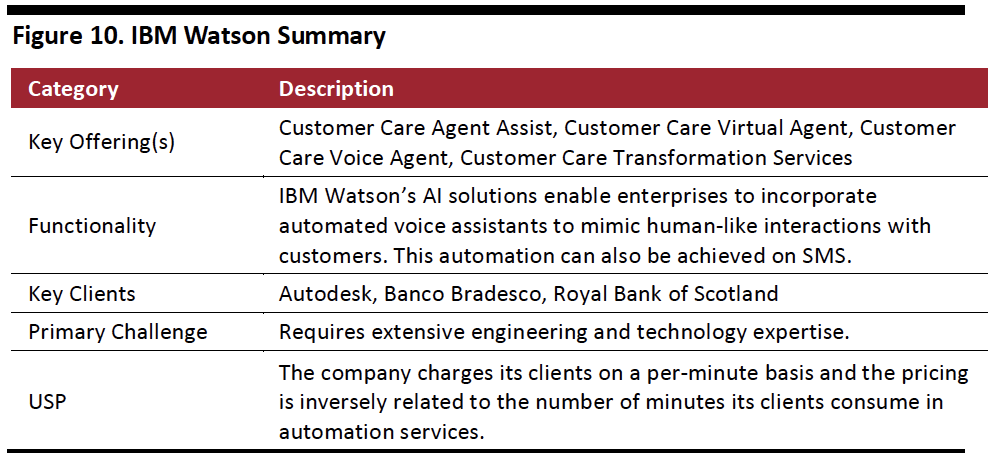 Source: Company website/Coresight Research[/caption]
Source: Company website/Coresight Research[/caption]
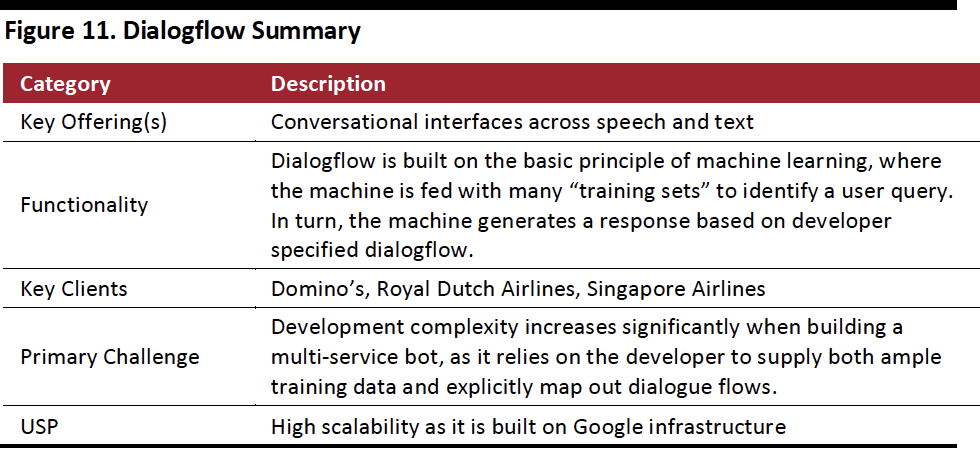 Source: Company website/Coresight Research[/caption]
Source: Company website/Coresight Research[/caption]
 Chatfuel
[caption id="attachment_90722" align="aligncenter" width="700"]
Chatfuel
[caption id="attachment_90722" align="aligncenter" width="700"]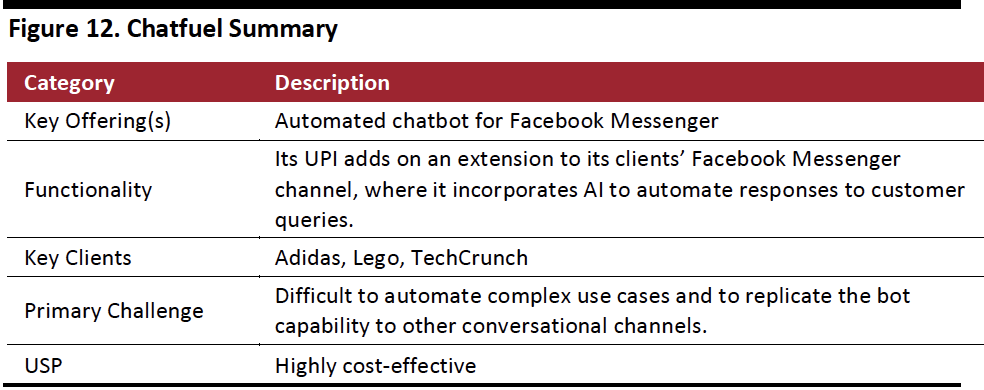 Source: Company website/Coresight Research[/caption]
The competitive advantage matrix below implies that Linc has strongly positioned itself in the market. Not only has the company capitalized on market advantages, but it also positioned its product to moderate the pitfalls in the market. It transfers queries from the bot to an agent with all the details of the previous interaction, and it is very easy to implement and integrate into clients’ existing platforms. Linc has also found growth avenues with its innovative offerings across all platforms.
[caption id="attachment_90723" align="aligncenter" width="700"]
Source: Company website/Coresight Research[/caption]
The competitive advantage matrix below implies that Linc has strongly positioned itself in the market. Not only has the company capitalized on market advantages, but it also positioned its product to moderate the pitfalls in the market. It transfers queries from the bot to an agent with all the details of the previous interaction, and it is very easy to implement and integrate into clients’ existing platforms. Linc has also found growth avenues with its innovative offerings across all platforms.
[caption id="attachment_90723" align="aligncenter" width="700"]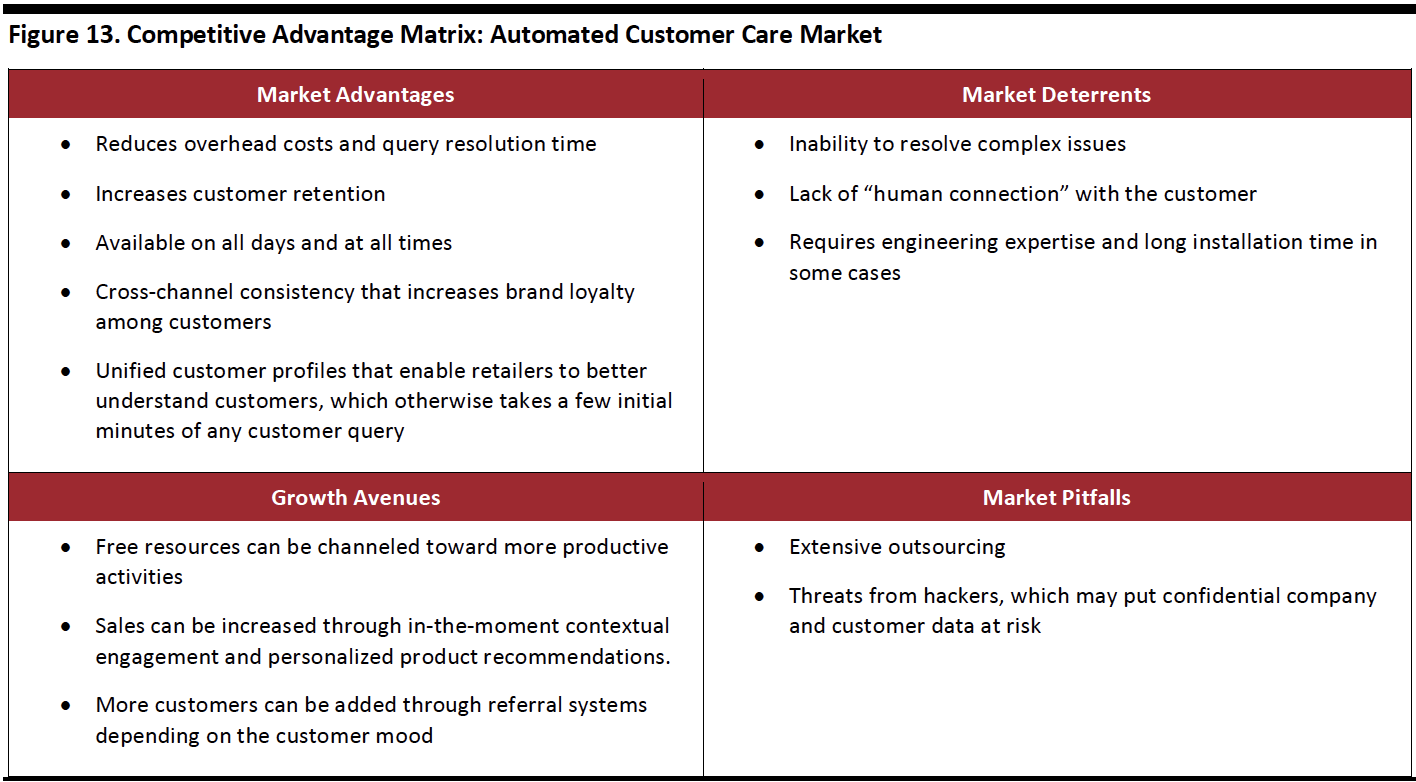 Source: Coresight Research[/caption]
Business Model
Linc’s revenue model consists of two components: annual SaaS subscription and additional usage fee.
Source: Coresight Research[/caption]
Business Model
Linc’s revenue model consists of two components: annual SaaS subscription and additional usage fee.
- Retailers and brands pay SaaS subscription fees based on the platform used and number of features incorporated.
- There is an additional fee that clients need to pay depending on their usage.
Key Management
[caption id="attachment_91033" align="aligncenter" width="700"]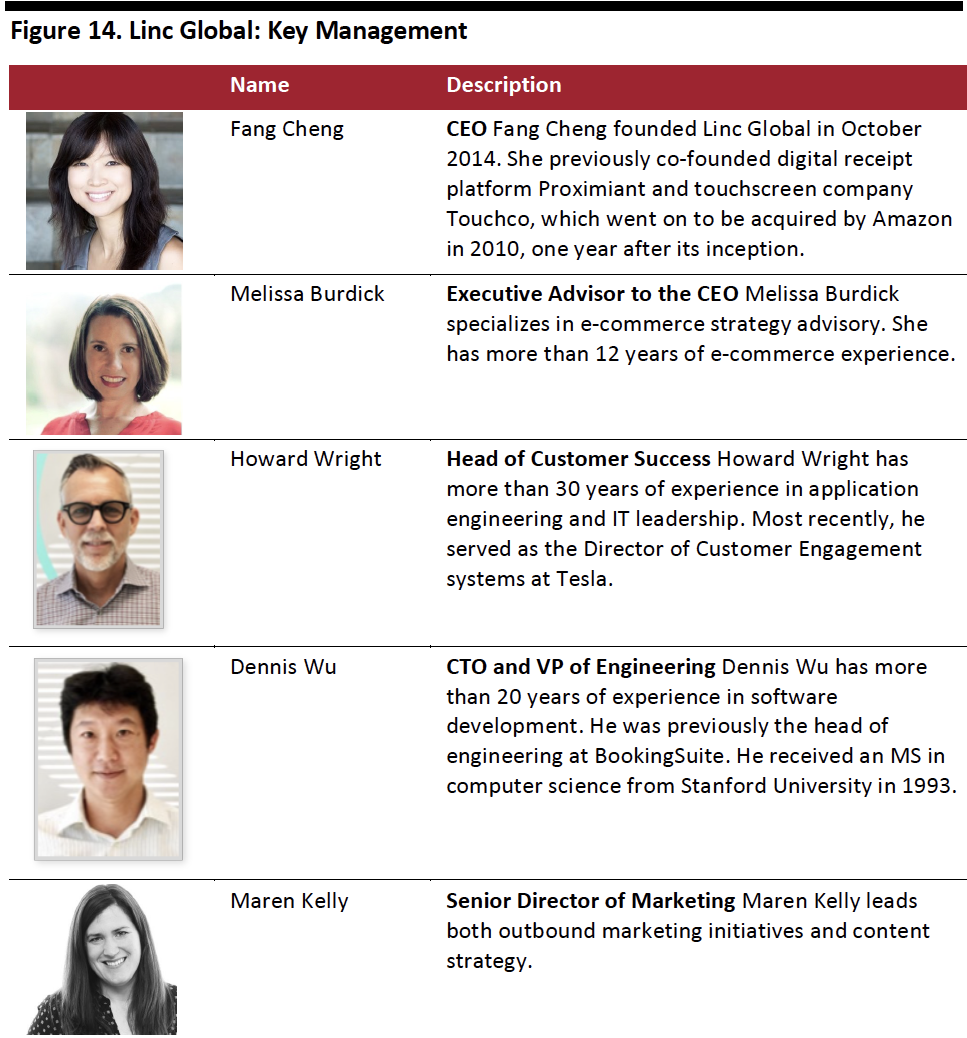 Source: Company website[/caption]
Source: Company website[/caption]
Recent and Upcoming Announcements
In May 2019, Linc announced the launch of Intelligent Promotion Botlet, which will provide its clients with a new channel to display promotions at the most relevant time to do so. In April 2019, the company launched its "Consultative Buying Botlet" and "Content Inspiration Botlet," which provide customers with more personalized shopping experiences and curated content. In the near future, Linc will deepen its offering in pre-purchase and engagement-oriented shopper assistance, including pre-built integrations with marketing clouds, social clouds, and mixed media support within its automated conversational experience.Coresight Research View
In order to maximize the benefits of automation, retailers must use automated shopper assistance not only as a means of resolving customer queries but also as a marketing channel. We believe that Linc is primed for growth based on the results its clients have achieved through their partnership with the company. Shoppers expect a holistic customer experience. Retailers need to provide automation across both messaging and voice assistant platforms. In the latter context, Linc’s offerings are quite comprehensive and place it a step ahead of its competitors.Company Contact www.letslinc.com